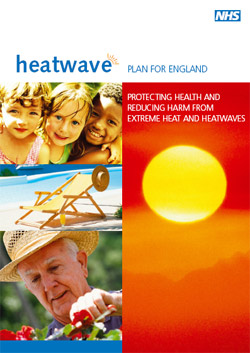 New advice to help people with respiratory problems cope in a heatwave is published today by the Department of Health.
New advice to help people with respiratory problems cope in a heatwave is published today by the Department of Health.
The Heatwave Plan has been updated to advise those suffering breathing problems that although ozone levels increase in hot weather, they drop in the evening. People with respiratory problems should stay inside during the hottest part of the day and windows should be kept shaded and closed when the temperature is hotter outside than inside.
The benefits of insulating against both heat and cold are outlined, with information on grants that are available from government. Providing cavity insulation in houses helps keep the heat out during summer, as well as keeping homes warm and reducing fuel costs and carbon emissions during colder weather.
More information on the Health Housing and Safety Rating System is also provided in the Plan. This encourages primary care trusts and local authorities to work more closely to target, assess and reduce the risk of vulnerable people living in the community who are living in homes that are too hot for their health.
Yvonne Doyle, Regional Director of Public Health (South East Coast) said:
“The heatwave plan urges carers to identify those most at risk before the hot weather begins. Once level 2, 'Alert and Readiness' has been triggered, those running care homes are urged to take extra care. They should monitor indoor temperatures four times a day, prepare cool areas, ensure there are enough staff to keep residents cool, identify those at greatest risk and make sure everyone has access to cold water and ice.”
Wayne Elliott, head of health forecasting at the Met Office said:
“The Department of Health’s Heatwave Plan is a vital part of the country's preparation for coping with extreme temperatures. The prolonged spells of hot weather that can happen each summer, particularly in our towns and cities, are a very real concern for vulnerable groups.”
The alert levels are now described from Level 1-4, but are also given colours that mirror the traffic light system.
The Heatwave Plan operates from 1 June to 15 September each year, and is based on information provided by the Met Office, which trigger alert levels according to ‘threshold temperatures’.
The four levels are:
Level 1 – Summer Preparedness and Long-term Planning: Green
Level 2 – Alert and Readiness: Amber
Level 3 – Heatwave Action: Red
Level 4 – Emergency: Red Emergency
Threshold temperatures
Region Day Night - (degrees Centigrade)
London 32 18
South East 31 16
South West 30 15
Eastern 30 15
West Mids 30 15
East Mids 30 15
North West 30 15
Yorks & Humber 29 15
North East 28 15
The Energy Saving Trust is able to provide practical advice and give information about grants that might be eligible. They can be contacted on 0800 512 012.
4. The Department first published its Heatwave Plan in 2004. In May 2008, the Plan was re-launched for summer 2008. The Plan provides advice and guidance and ensures those organisations involved in providing health and social care services know what actions to take in preparation for, and in the event of, a heatwave.
The Heatwave Plan, and its advice and guidance, will help save lives. As the experience of 2003 demonstrated, particularly for those over 75, precautions need to be taken to avoid serious harm from the effects of heat on health. The heat creates strain on the heart, can make respiratory symptoms worse and cause heat exhaustion and heat stroke.
Timely preventive measures can reduce excess deaths. Extreme heat kills more quickly than the cold, so it is essential to identify those at most at risk and to act quickly if a heatwave is predicted.
The experience of 2003 is a reminder that heat can be fatal. Across Europe in 2003, the number of people who died because of the heat is estimated at 27,000. In England, there were approximately 2,000 excess deaths - 85% of which were people aged 75 and over. Those living in care homes experienced the greatest increased risk of death. The Heatwave Plan addresses this threat.
The Heatwave Plan is available from the E-Library Database or by clicking on the pic above.